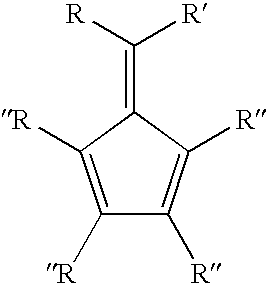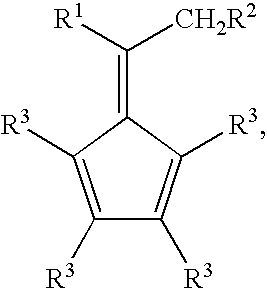Synthesis of 6-aryl-6-alkyl fulvenes, 6-aryl-6-alkenyl fulvenes, and related compounds
a technology of alkyl fulvenes and alkenyl fulvenes, which is applied in the field of organic synthesis, can solve the problems of tedious and difficult extraction, purification, and subsequent use of desired isomers, and achieve the effects of high chemical selectivity, high yield of desired products, and reduced extraction and purification costs
- Summary
- Abstract
- Description
- Claims
- Application Information
AI Technical Summary
Benefits of technology
Problems solved by technology
Method used
Image
Examples
example 1
Preparation of 6-phenyl-6-(3-butenyl)fulvene using Cyclopentadienyl Grignard Reagents
[0249]Method 1. A 1 L round bottomed flask was charged with 1-phenyl-4-penten-1-one (50 g, 313 mmol), THF (270 mL), and a stir bar, and cooled to 0° C. Cyclopentadienyl magnesium chloride (325 mL of an approximately 1.1M solution in THF, 345 mmol) was added dropwise via an addition funnel, while maintaining the temperature at 0° C. The resulting mixture was slowly warmed to room temperature, refluxed for 3 hours, and then cooled to room temperature. This reaction mixture was then neutralized with 2M HCl, and extracted with pentane. The pentane extracts were dried with sodium sulfate, filtered, and the filtrate evaporated to dryness to afford 70 g of red oil. Elution of this oil through silica using heptane afforded 39 g (60% isolated and purified yield) of the product 6-phenyl-6-(3-butenyl)fulvene as a red oil.
[0250]Method 2. An alternative preparation of 6-phenyl-6-(3-butenyl)fulvene to that detail...
example 2
Comparative Preparation of 6-phenyl-6-(3-butenyl)fulvene using Lithium Cyclopentadienyl
[0252]A 1 L round bottomed flask was charged with 1-phenyl-4-penten-1-one (38.4 g, 240 mmol), THF (100 mL), and a stir bar, and cooled to −78° C. Cyclopentadienyl lithium (245 mmol) in THF (200 mL) was added dropwise via an addition funnel while maintaining the temperature at −78° C. The resulting mixture was slowly warmed to room temperature and stirred for 3 days. After this time, the reaction mixture was neutralized with 2M HCl and extracted with pentane. The pentane extracts were collected and dried with sodium sulfate, filtered, and the filtrate evaporated to dryness to afford 46 g of red oil. Elution of this oil through silica using heptane afforded 19 g (38%) of the product 6-phenyl-6-(3-butenyl)fulvene as a red oil.
example 3
Comparative Preparation of 6-phenyl-6-(3-butenyl)fulvene using KOEt / EtOH
[0253]A solution of potassium ethoxide (5.30 g, 63 mmol) dissolved in 250 mL of absolute ethanol was prepared. This KOEt / EtOH solution was cooled in a dry ice bath and 10 mL of freshly cracked cyclopentadiene was added. The solution was stirred for 3 hours at dry ice temperature, after which time 10 μL (62.4 mmol) of 1-phenyl-4-penten-1-one was added. This solution was stirred for 4 hours at dry ice temperature, then warmed to 5° C. and stirred for 65 hours. While the reaction mixture was then cooled to ice temperature, 50 mL of 3 M HCl, followed by 100 mL of water were added. The product was extracted from the reaction solution with both ether and pentane, and the combined organic layers were washed with water. The resulting solution was dried over sodium sulfate, filtered, and concentrated to afford 12.65 g of the crude product as a red oil. The desired fulvene, 6-phenyl-6-butenylfulvene, was shown by GC to co...
PUM
| Property | Measurement | Unit |
|---|---|---|
| molar ratio | aaaaa | aaaaa |
| molar ratio | aaaaa | aaaaa |
| molar ratio | aaaaa | aaaaa |
Abstract
Description
Claims
Application Information
 Login to View More
Login to View More - R&D
- Intellectual Property
- Life Sciences
- Materials
- Tech Scout
- Unparalleled Data Quality
- Higher Quality Content
- 60% Fewer Hallucinations
Browse by: Latest US Patents, China's latest patents, Technical Efficacy Thesaurus, Application Domain, Technology Topic, Popular Technical Reports.
© 2025 PatSnap. All rights reserved.Legal|Privacy policy|Modern Slavery Act Transparency Statement|Sitemap|About US| Contact US: help@patsnap.com



